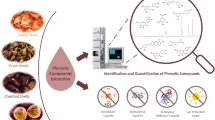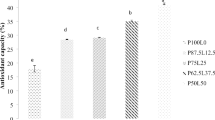Abstract
Herbero de la Sierra de Mariola is a traditional Spanish herb liqueur which can have up to 15 different plants. The aim of this study was to help in deciding which are the best suited herbs to be used to prepare a liqueur with the highest contents of bioactive compounds and their functional properties. Chemical parameters (FT-IR spectroscopy), total contents of bioactive compounds (polyphenols, flavonoids, and phenolic acids), sensory quality (total content of volatile compounds and aroma intensity), antioxidant activity (DPPH‧ and ABTS+), and antimicrobial activity, and sensory intensity were the parameters studied. In general, the best highest contents of the bioactive compounds and functional activities were found in liqueurs of the Lamiaceae family. An optimized version of this traditional liqueur might contain (i) winter savory, (ii) fennel, (iii) thyme, and (iv) peppermint. This study can be an example of how the scientific knowledge can be used to optimize traditional products, such as an Herbero de la Sierra de Mariola, and why not also to support the advantages of these products to establish future marketing campaigns.

Similar content being viewed by others
References
Martínez-Francés V, Hahn E, Ríos S, Rivera D, Reich E, Vila R, Cañigueral S (2017) Ethnopharmacological and chemical characterization of Salvia species used in Valencian traditional herbal preparations. Front Pharmacol 8. https://doi.org/10.3389/fphar.2017.00467
European Commission (2018) E-SPIRIT-DRINKS. Database on Geographical Indications Protected in the European Community for Spirits Originating in Member States and Third Countries. http://ec.europa.eu/agriculture/spirits Accessed 28 Jan 2018
Ministerio de Agricultura PyA (2004) ORDEN APA/3382/2004, de 5 de octubre, por la que se ratifica la modificación del Reglamento de las Denominaciones Específicas «Aperitivo-Café de Alcoy», «Cantueso de Alicante ». In: «Herbero de la Sierra de Mariola (Alicante)», y «Anís de Alicante», y su Consejo Regulador. Consejo Regulador de las Bebidas Espirituosas Tradicionales de Alicante). BOE, Madrid
Friedel M, Patz CD, Dietrich H (2013) Comparison of different measurement techniques and variable selection methods for FT-MIR in wine analysis. Food Chem 141:4200–4207. https://doi.org/10.1016/j.foodchem.2013.06.120
Sánchez-Moreno C, Larrauri JA, Saura-Calixto F (1998) A procedure to measure the antiradical efficiency of polyphenols. J Sci Food Agric 76:270–276. https://doi.org/10.1002/(SICI)1097-0010(199802)76:2%3C270::AID-JSFA945%3E3.0.CO;2-9
Giuffrè AM, Zappia C, Capocasale M (2017) Physicochemical stability of blood orange juice during frozen storage. Int J Food Prop 20:1930–1943. https://doi.org/10.1080/10942912.2017.1359184
Giuffrè AM, Zappia C, Capocasale M (2017) Effects of high temperatures and duration of heating on olive oil properties for food use and biodiesel production. JAOCS 94:819–830. https://doi.org/10.1007/s11746-017-2988-9
Re R, Pellegrini N, Proteggente A, Pannala A, Yang M, Rice-Evans C (1999) Antioxidant activity applying an improved ABTS radical cation decolorization assay. Free Radic Biol Med 26:1231–1237. https://doi.org/10.1016/S0891-5849(98)00315-3
Singleton VR, J (1965) Colorimetry of total phenolics with phosphomolybdic-phosphotungstic acid reagents. Am J Enol Vitic 16:144–158
Willett WC (2002) Balancing life-style and genomics research for disease prevention. Science 296(5568):695–698. https://doi.org/10.1126/science.1071055
Farmakopea Polska (2011) Farmakopea Polska. https://farmakopeapolska.wordpress.com/. Accessed 23 Jan 2018
Hernández F, Noguera-Artiaga L, Burló F, Wojdyło A, Carbonell-Barrachina AA, Legua P (2016) Physico-chemical, nutritional, and volatile composition and sensory profile of Spanish jujube (Ziziphus jujuba Mill.) fruits. J Sci Food Agric 96:2682–2691. https://doi.org/10.1002/jsfa.7386
Hojjati M, Lipan L, Carbonell-Barrachina ÁA (2016) Effect of roasting on physicochemical properties of wild almonds (Amygdalus scoparia). JAOCS 93:1211–1220. https://doi.org/10.1007/s11746-016-2868-8
Arzberger ULD (2008) Fourier transform infrared spectroscopy with multivariate analysis as a novel method for characterizing alcoholic strength, density, and total dry extract in spirits and liqueurs. Food Anal Met 1:18–22
European Commission (2008) Regulation (EC) no 110/2008 of the european parliament and of the council on the definition, description, presentation, labelling and the protection of geographical indications of spirit drinks and repealing Council Regulation (EEC) No 1576/89. http://eur-lex.europa.eu/LexUriServ/LexUriServ.do?uri=OJ:L:2008:039:0016:0054:EN:PDF. Accessed 23 Jan 2018
Bekut M, Brkić S, Kladar N, Dragović G, Gavarić N, Božin B (2018) Potential of selected Lamiaceae plants in anti(retro)viral therapy. Pharmacol Res 133:301–314. https://doi.org/10.1016/j.phrs.2017.12.016
Sytar O, Hemmerich I, Zivcak M, Rauh C, Brestic M (2018) Comparative analysis of bioactive phenolic compounds composition from 26 medicinal plants. Saudi J Biol Sci 25:631–641. https://doi.org/10.1016/j.sjbs.2016.01.036
Sokoł-Łȩtowska A, Kucharska AZ, Wińska K, Szumny A, Nawirska-Olszańska A, Mizgier P, Wyspiańska D (2014) Composition and antioxidant activity of red fruit liqueurs. Food Chem 157:533–539. https://doi.org/10.1016/j.foodchem.2014.02.083
Vacca V, Piga A, Del Caro A, Fenu PAM, Agabbio M (2003) Changes in phenolic compounds, colour and antioxidant activity in industrial red myrtle liqueurs during storage. Nahrung Food 47:442–447. https://doi.org/10.1002/food.200390098
Li W, Beta T (2011) Evaluation of antioxidant capacity and aroma quality of anthograin liqueur. Food Chem 127:968–975. https://doi.org/10.1016/j.foodchem.2011.01.066
Huang D, Boxin OU, Prior RL (2005) The chemistry behind antioxidant capacity assays. J Agric Food Chem 53:1841–1856. https://doi.org/10.1021/jf030723c
Rodríguez-Solana R, Salgado JM, Domínguez JM, Cortés-Diéguez S (2016) Phenolic compounds and aroma-impact odorants in herb liqueurs elaborated by maceration of aromatic and medicinal plants in grape marc distillates. J I Brewing 122:653–660. https://doi.org/10.1002/jib.377
Casazza AA, Aliakbarian B, Sannita E, Perego P (2012) High-pressure high-temperature extraction of phenolic compounds from grape skins. Int J Food Sci Technol 47:399–405. https://doi.org/10.1111/j.1365-2621.2011.02853.x
Sperber WH (2009) Introduction to the microbiological spoilage of foods and beverages. In: Sperber WH, Doyle MP (eds) Compendium of the microbiological spoilage of foods and beverages. Springer, New York, pp 1–40
Hammond JB, Price M A (1999) The control of microbiologica spoilage of beer. J I Brewing 105:113–120
Harris KL, Bobe G, Bourquin LD (2009) Patulin surveillance in apple cider and juice marketed in Michigan. J Food Prot 72:1255–1261. https://doi.org/10.4315/0362-028X-72.6.1255
Acknowledgements
Authors want to thank Consejo Regulador Bebidas Espirituosas Tradicionales de Alicante (http://www.licoresdealicante.com/) for kindly providing the all liqueurs used in this study. Luis Noguera-Artiaga was funded by an FPU grant from the Spanish government (FPU014/01874).
Author information
Authors and Affiliations
Corresponding author
Ethics declarations
Conflict of interest
The authors declare that they have no conflict of interest.
Compliance with ethics requirements
This article does not contain any studies with human or animal subjects.
Additional information
Publisher’s Note
Springer Nature remains neutral with regard to jurisdictional claims in published maps and institutional affiliations.
Rights and permissions
About this article
Cite this article
Issa-Issa, H., Ivanišová, E., Noguera-Artiaga, L. et al. Effect of the herbs used in the formulation of a Spanish herb liqueur, Herbero de la Sierra de Mariola, on its chemical and functional compositions and antioxidant and antimicrobial activities. Eur Food Res Technol 245, 1197–1206 (2019). https://doi.org/10.1007/s00217-019-03247-7
Received:
Revised:
Accepted:
Published:
Issue Date:
DOI: https://doi.org/10.1007/s00217-019-03247-7




